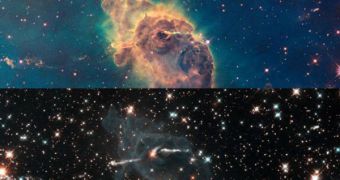According to scientists at the Harvard-Smithsonian Center for Astrophysics, it may be that magnetic fields play a much more important and decisive role in stellar formation than first anticipated. The conclusion was drawn after the experts made a comparative analysis of turbulences versus magnetic fields. The two phenomena were the ideal candidates to explain why stellar nurseries – areas of intense stellar formation – only produced small amounts of stars, at specific locations, as if something was hindering the growth process.
The accepted knowledge on stellar formation at this point holds that stellar nurseries, which are, in essence, molecular clouds, filled with cosmic dust and gas, occasionally and under precise circumstances fall under their own gravitational pull into an area much smaller than their original size, and, as a result, ignite. However, if that alone were true, then all sections of known molecular clouds should have young, blue stars, whereas this is not the case. Therefore, other forces must be at work to prevent stars from appearing everywhere, and magnetic fields and turbulences have been the best bet.
“The relative importance of magnetic fields versus turbulence is a matter of much debate. Our findings serve as the first observational constraint on this issue,” CfA astronomer Hua-bai Li, who has been a member of the team that has conducted the new research, says. He and his team have analyzed 25 dense patches of cloud cores, each about one light-year across. Their attention was focused on polarized light, which exhibits electrical and magnetic arrangements along specific lines, ScienceDaily reports.
They then inferred the strength of the magnetic field in each of the 25 patches, and proceeded towards comparing the figures with those obtained from other portions of the same molecular clouds. They uncovered that the magnetic fields were very likely to align themselves in the same direction, even when accounting for the fact that size scales and matter densities were several orders of magnitude apart. The team then realized that, if turbulences were to be the main actor in stellar nurseries, then the magnetic field lines would have to point in all directions, as the gas would be swirled and mixed.
“Our result shows that molecular cloud cores located near each other are connected not only by gravity but also by magnetic fields. This shows that computer simulations modeling star formation must take strong magnetic fields into account,” Li concludes. A paper covering the find has been accepted for publication in an upcoming issue of The Astrophysical Journal.

 14 DAY TRIAL //
14 DAY TRIAL //